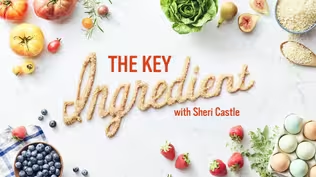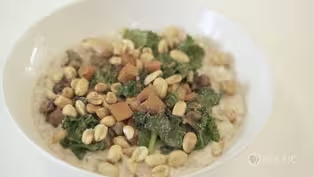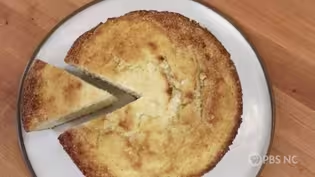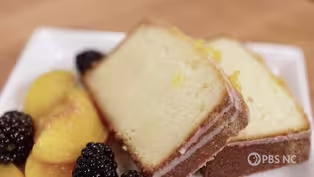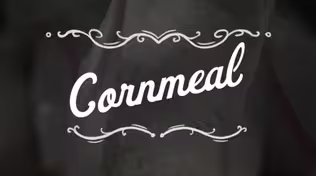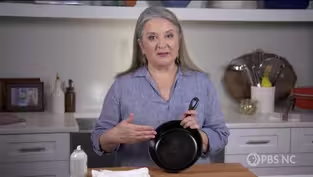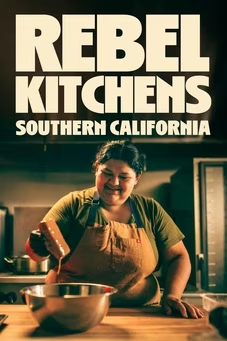
Cornmeal of the Castle
9/11/2023 | 26m 47sVideo has Closed Captions
Cornmeal has a special place in Sheri’s heart; she shares her mouth-watering recipes.
Cornmeal has a special place in Sheri’s heart as she shares her mouth-watering cornmeal pound cake with glaze and lemon sugar that will make everyone happy. And it’s a scrumptious cornmeal confession as Sheri makes her fabulous cornbread recipe with family cornmeal. Sheri cooks along with Cheetie Kumar and says a helpful hint about the best way to season and care for your cast iron skillet.
Problems playing video? | Closed Captioning Feedback
Problems playing video? | Closed Captioning Feedback
The Key Ingredient is presented by your local public television station.

Cornmeal of the Castle
9/11/2023 | 26m 47sVideo has Closed Captions
Cornmeal has a special place in Sheri’s heart as she shares her mouth-watering cornmeal pound cake with glaze and lemon sugar that will make everyone happy. And it’s a scrumptious cornmeal confession as Sheri makes her fabulous cornbread recipe with family cornmeal. Sheri cooks along with Cheetie Kumar and says a helpful hint about the best way to season and care for your cast iron skillet.
Problems playing video? | Closed Captioning Feedback
How to Watch The Key Ingredient
The Key Ingredient is available to stream on pbs.org and the free PBS App, available on iPhone, Apple TV, Android TV, Android smartphones, Amazon Fire TV, Amazon Fire Tablet, Roku, Samsung Smart TV, and Vizio.
Providing Support for PBS.org
Learn Moreabout PBS online sponsorship[upbeat music, bass lead] - [Sheri] I love corn meal.
I use it in all kinds of recipes, but I also love the history and tradition of grinding corn meal.
[mill grinding] You can't talk about cornmeal without talking about corn bread, and we're going to cook up a recipe that I am proud to call my own.
And then we'll talk about that age old debate of whether corn bread should be sweet or savory, and then go fully sweet in a great cornmeal poundcake.
[upbeat music] And you've got to see what my friend, Chef Cheetie Kumar, is going to make with cornmeal.
It's a recipe she grew up with.
- [Cheetie] Here you go my friend.
- Amazing.
- [Sheri] Let's have some.
- [Cheetie] Let's try some.
- That's insanely good.
I'm Sheri Castle.
I write cookbooks.
I write for food magazines.
I cook.
I teach, and I collect stories.
And my favorite stories are the ones behind our best loved home recipes.
Is it time to shuck 'em?
- [Man] It's time to shuck 'em.
Cheers!
- [Sheri] Oh, that's awesome.
I will go out and explore from the ground up the best ingredients that go into some of our most beloved family recipes.
It's all about the food, the flavors, and finding the key ingredient.
[happy music] Today we're headed to my parents' backyard in Watauga County, high in the Blue Ridge Mountains.
The place that I'll always call home.
Just like we do each fall, my dad and I will crank up our antique gristmill to make fresh, stone ground corn meal.
Hey, Hey, Hey.
Hey daddy.
How are you?
So happy to be here.
It's a little hard work.
It's a whole lot of fun.
And we wind up with plenty of delicious cornmeal to boot.
- [Sheri's Dad] I love you the most, the fact that you're keeping the family tradition going.
- [Sheri] So, we all set up?
- [Sheri's Dad] I set this thing up yesterday afternoon.
Make sure I had everything lined up.
And it's a little difficult to set it up on pavement because it wants to shift around.
Better if it was in a building tied down.
When, like I say, I can remember when my grandfather had it and he-- Was a community mill.
Here in the mountains there'd be a mill about ever few miles where people could literally walk with, I think, what they called a turn of corn, which was about the size of a pillowcase.
And people would fill that full of corn, take it to the meal, and in most cases they would take a portion of corn as pay for grinding it.
- That's what they call a till, isn't it?
- I think so.
- Yep.
- [Sheri's Dad] And now I think it's about the only one in this area that's still operating.
It's a unique keepsake.
- [Sheri] Exactly.
- [Sheri's Dad] And it does make good corn bread because it's fresh stone ground.
- That's why everybody thinks my recipe's good.
It's actually the cornmeal.
Don't tell them, okay?
Shh.
- I hear you, but but even I can make the cornbread.
So it don't take a rocket scientist to make it [Sheri laughing] with your recipe.
- [Sheri] No, it just takes a skillet.
- Yeah.
A cast iron skillet.
That's it.
Yeah.
- [Sheri] All right, daddy, so give me my annual refresher on what goes with what.
Tell me what everything is.
- [Sheri's Dad] This is just a two cylinder engine.
But we use this thing and I hate to say it, but it has personality.
There's times when it stubs up and you lose your-- - [Sheri] That's how you know its ours.
- Yeah, lose your religion trying to get it to work.
We get the mill running and then we pour the corn in and you adjust the flow as to how fast it naturally happens.
- [Sheri] Show me where that happens.
- All right, this this lines up and that pushes the stones closer together.
- Mm-hmm.
- And the closer you run them, the finer the meal is ground.
But if you get them so close they touch, then you've ruined it.
You have to take it apart and sharpen it again.
- [Sheri] Okay.
- [Sheri's Dad] And then this lever right here, that adjusts the amount of grain that comes down the chute and goes in and is ground.
- [Sheri] Mm-hmm.
- But then it falls into here, - [Sheri's Dad] Yeah, Uh-huh.
- And then the broken grains, it's almost like a built-in quality control, it keeps the broken ones out the back.
- [Sheri's Dad] It's designed, anything less than a full kernel of corn, it falls out and it's chicken feed or something like that.
And it don't do any good to pour it back in again because it'll just fall back out again.
- There you go.
Thank you, Daddy.
- Well, you're welcome.
[upbeat music] - [Sheri] Like barbecue, there are lots of lively opinionated debates on how to make cornbread.
Some people want to put sugar in it while others can't imagine why anyone would enjoy sweet corn bread.
The truth is it's all relative.
Sometimes, literally.
People tend to like the kind of corn bread that their family makes, and that is fine.
And the real secret to corn bread, no matter the recipe, is to pay attention to the corn meal.
Believe it or not, we did not have a family recipe.
So I decided to create one of own, and it begins by putting some fat in the skillet.
Now this is bacon fat, but you can use oil or butter for this as well.
A screaming hot skillet is the secret to my crust.
So I'm going to pop this into a 450 degree oven and let them get til it's almost shimmering hot.
Cornbread is a quick bread, which means it comes together in one bowl.
I have my corn meal, and this is stone ground corn meal.
And I do add a little bit of flour.
And that is because coarse corn meal can sometimes be a little too coarse when it comes time to cut the corn bread.
If you want nice, tidy slices, that little bit of flour will hold it all together.
Then I'm going to put in salt, baking powder, baking soda, and yes, just a tiny bit of sugar, not to make it sweet, but a little bit of sugar will give you a golden, beautiful crust.
It's really in there for looks more than flavor.
It is a quick bread in that it doesn't contain yeast.
So anytime you're making a quick bread, you want to really stir your dry ingredients so that that leavening is evenly distributed all the way through.
And two more ingredients.
I'm a huge fan of liquid buttermilk, and I have shaken it up, and I'm going to add one large egg and whisk this together until I can't see the yolk anymore.
When I can lift my whisk out and nothing sticks to it.
We know the egg is incorporated.
And then you pour the wet into the dry and stir them together.
And stir only until everything is moist and there are no wispy bits of dry.
There's nothing to be gained by over stirring your batter.
And that's it.
When you're using baking powder and baking soda in a recipe, they'll only do their leavening job for a few minutes and then they quit.
So you want to let this sit no more than about five, 10 minutes at the most.
But if you put your pan at the beginning, it's going to be ready when you are.
So my pan and my bacon fat are screaming hot from being in the oven and preheating together.
And I'm going to quickly add my batter.
It's probably going to sizzle.
Make that signature sizzle that makes the outside extra crispy, almost like a well-made hush puppy.
That fat, that bubbles up around the edge, is going to go over the top.
It's going to add color and flavor to the top of the corn bread as well.
A wedge of freshly cooked corn bread, or even a broken off hunk is the perfect side dish to almost anything.
Chili, soup, a vegetable plate.
But sometimes I just want corn bread with my corn bread topped with gobs of butter.
When I was a little girl, my granddaddy would take a dinner plate and put a big gob of butter on it and drizzle on a bunch of syrup, honey, or sorghum, cane syrup, even Karo syrup, if that's what we had, and stirred it all up and we put it on our cornbread It was this little touch of sweetness that made that cornbread feel like a dessert, a real treat.
And that's what I'm going to make today.
So I have here two sticks of softened butter that's at room temperature, and I'm going to stir it until it's soft and creamy.
And once your butter is nice and soft and creamy, going to add in a little bit of powdered sugar, which can be an unusual ingredient, but let me tell you why I do it.
It's not to add more sweetness.
We're going to get plenty of that from our sorghum syrup.
The little bit of powdered sugar will make this hold in the refrigerator for several days.
So you can make a lot of it and then serve it through the week as you need it.
In goes my sorghum.
Now I'm going to stir this up until it's smooth and creamy.
And hot corn bread goes great with a butter, like honey butter or this wonderful sorghum butter.
So once your butter mixture is smooth, you can put it in a pretty bowl and have it ready to go on the table.
So my hot cornbread has just come from the oven.
I think that hot cornbread is so special that people should be sitting at the table and waiting for it.
But if you do need to hold the cornbread for a few minutes, go ahead and flip it out of the skillet, because if it stays in there, it's gonna steam an undo that delicious crush you've worked so hard to make.
Oh yeah.
Look at that beautiful edge.
Now I have my butter all ready.
Let's cut into this and see what awaits.
I love how it feels when that first slice let's go.
Now while this is steaming hot, of course, I have to top this with a dollop of my delicious sorghum butter.
[upbeat music] ♪ It's ready.
♪ ♪ Yes, it's ready.
♪ ♪ So just let it all begin.
♪ - [Sheri] We are heading to the kitchen of my dear friend, who's going to teach us an Indian cornmeal recipe that she learned from her mom.
- [Cheetie] My name is Cheetie Kumar.
I am the chef and co-owner of Garland in downtown Raleigh.
We are a locally sourced Indo pan-Asian restaurant.
I'm fascinated by the way, ingredients have made it from one part of the world to the other, just like my family.
I have played music for a big part of my life.
So I'm a guitar player in our band, Birds of Avalon.
I think that playing in a band for all those years and sort of being self-managed helped so much with all the aspects of what we do now.
[upbeat music] - Hello, my friend.
How are you today?
- It's nice to see you.
- I brought you a present.
This is some fresh ground corn mill.
- Oh, my God.
- I know you love corn meal the way that I do.
- I do.
- And you have promised you're going to teach me a recipe that you have been eating your whole life.
Do I have that right?
- Variations of it, but yeah.
- Okay.
So what's it called?
- It's upma.
And upma is sort of like the word for porridge in India.
This recipe is kind of very typical Indian in that we start with aromatics and we kind of have something gentle and not super flavorful.
- [Sheri] Uh-huh.
- [Cheetie] And then we finish it with a bunch of spices or aromatics, and that adds this top layer.
And the bottom layer and the top layer kind of interact together.
And that's why Indian food can seem so complex, but it's really very simple.
- All right.
You got to get me started on this.
- All right.
So, I really love coconut oil and that's just some onions.
- Oh, I can smell the coconut.
That's lovely.
- Its so nice.
And it adds this really lovely kind of savory sweetness to cornmeal.
And I think cornmeal is kind of sweet and savory.
And this is a little chopped green cayenne pepper.
You can use as much or little as you like.
And this is just some freshly cracked tellicherry pepper.
And I'm going to add about a cup and a half of really nice coconut milk.
With this coconut milk, I'm just going to add a whole lot of water.
This is about five cups.
I'm gonna make sure that this is seasoned properly.
There's nothing worse than bland cornmeal, right?
- And it loves salt.
- It really does.
And you know, you kind of want to make this a little bit saltier than you think it should be.
And we're just going to bring this to a gentle boil.
So now just kind of drizzle this in.
This is about a cup.
This doesn't look like enough corn meal for the amount of liquid, but trust me, it is.
- Somebody I used to know, says it will release its starch.
And then they'll say, and then the starch will begin to hold.
I thought that was archaic, but it's such a good image.
- It is.
So while this is simmering, I'm going to make a little veggie topping.
- So these are toppings of opportunity.
- Exactly.
- It's either what you find at the farmer's market or what you have.
- [Cheetie] And this is ghee.
You can use olive oil.
You can use butter.
Some finely chopped ginger, some coriander, and I'm going to throw the shiitakis in there.
And one thing with mushrooms that I've discovered lately is not salting them because I really want them to retain their flavor.
So I'm toasting them and I want the water to evaporate slowly and concentrate the mushroom flavor in here.
- Exactly.
- And throw in these sweet potatoes, too.
They're already cooked, so I'm really just looking for a little bit more caramelization.
Once the mushrooms are all the way brown, then you can start salting because the water's already gone away.
And now we're going to do, sort of the finishing layer, which is such an important part of Indian cooking.
This part is called tarka or chhonk.
So we started with onions and a little chili.
We're going to put another layer of those very things, along with some, some more friends.
And this is a red dal, it's a lentil, and I'm going to use it as a textural element.
And so you just kind of toast it.
And as soon as it starts to sizzle, I'm going to zip in some Curry leaves and they'll pop.
And I'm going to put more chilis in here.
And again, you can skip that if you don't want any more heat.
And, you know, you could just stop here, but we're not going to because we're fancy.
- So fancy.
- So we're going to season, of course, and this is ginger garlic paste.
So this is gonna go pretty quickly.
We're just sweating all of this stuff.
I'm going to add a little pinch of chili powder.
- Great color on that.
- Isn't it beautiful.
I'm going to kind of de-glaze all of this with a little bit more, tiny bit more coconut milk, and a little cream.
I like cornmeal with a little pinch of sugar.
So we put all of our bloomed aromatics in here.
We have our shiitakis with sweet potatoes.
And why not?
I'm going to add a little bit more coconut milk.
- Mm-hmm.
I'm going to add a tiny bit of chicken stock.
- Okay.
- Then I'm just going to almost just steam the greens, just start to soften.
And you could definitely just dump all of this right in there.
And you know, I guess that would be more of like a Southern style.
- It was probably more like somebody who can't find a second piece of Tupperware with the lid.
[Sheri laughing] - I mean, story of our life, right?
[both laughing] So I'm going to finish this with a little bit of lime juice.
- One of my favorite things.
- And why not throw some in here too?
- Exactly.
- Cause everything benefits from a little bit of acid.
- And I think that's something else too, that sometimes when we taste a food that is flat, and this certainly isn't, but if we did, you check salt first, if you know there's enough salt but there's still that little something missing, it's acid.
- It is.
Most often you can fix something at the end with acid.
- [Sheri] Exactly.
That goes on top.
- [Cheetie] And then this, yeah.
- [Sheri] And that hint of flavor.
- And a little texture.
And don't forget the peanuts.
- [Sheri] Yeah.
Crunch, a little more salt, one more texture.
- There you go.
My friend.
- Amazing.
Let's have some.
- Let's try some.
- That's insanely good.
Because what you're doing here, is you're giving me, there's nothing in here I've not had before, but I've never had it like this.
Right.
But you could've.
- And I'm gonna.
[Cheetie laughing] - We're gonna have to do this again.
- Like often.
- Tell me when.
I'll be here.
- You bet.
Mmm mmm mmm.
- That is good.
You guys want some?
- [Sheri] Now we've talked about whether sugar belongs in corn bread and we will never agree, nor should we.
But everyone can agree that sugar belongs in a cornmeal poundcake.
[upbeat music] This is a corn meal pound cake.
I love making pound cakes.
It's my favorite kind of cake to make.
You do a little work, you get lots of rewards.
Now this one does include corn meal for a little bit of crunch.
Let's get started.
So I have here some, all purpose flour, and I'm going to add some stone ground corn meal.
And then I'm going to add a little baking soda and some salt.
You want to take those few extra seconds and really whisk that leavening into your dry ingredients so that it will be evenly distributed into the batter.
And then we're going to take to the mixer.
And the first thing that goes in is some butter.
[mixer humming] And then we're going to add the sugar.
You know, sugar usually goes in with the fat, the butter, in a recipe where it gets nice and creamy, and that's one of the secrets to pound cake.
You don't want to rush that step.
It's going to take about five minutes for that sugar and that butter to become one.
The way you know when butter and sugar have creamed enough for a pound cake, if you rub it, it's lost most of its grit and it feels more like cake frosting.
And now I'm going to add my eggs one at a time.
And when you can no longer see any yellow, when it's all in there, it's time to add another egg.
Make sure you get the batter off of the paddle attachment.
A lot of pound cakes will have you add the dry ingredients on the mixer, but for this one, I like to do these last few things by hand.
So I'm going to add in my flour, about half of it.
And I'm going to, just with my spatula, I'm going to stir this in.
But the less storing you can do to accomplish this, the better this cake is going to be.
And then I'm going to put in sour cream, this is full fat sour cream.
And then the rest of your flour mixture.
And then last but not least, we have the zest of a lemon and then we have some fresh lemon juice.
So when everything is mixed in, [lively music] make sure your oven is preheated, and that you've positioned a rack in the middle of the oven.
That's the sweet spot for a cake to cook evenly.
So I love an unexpected element of an ur in a sweet dessert.
And for this I'm making a simple basil syrup.
So easy.
I've got water in this pan and this is a little bit of a sweet wine, like a Riesling or a Moscato.
Them you're gonna add some sugar, some fresh lemon juice, and then we're going to bring this to a quick boil and stir until the sugar dissolves.
As soon as the sugar's dissolved, you drop in half a vanilla bean and a great big handful of basil.
It's gonna be about a cup, lightly compacted, just fresh basil leaves.
And lift it off the heat to cool at room temperature.
So now my syrup is cooled room temperature, and I'm going to put this over some fresh fruit.
Today I'm doing blackberries and pitted peeled peaches, but you can do any combination of berries you like, or just one of these or the other.
I was once invited to cook at a competition at a local farmer's market, and they gave me a basket of ingredients.
I didn't know what was going to be in it.
Basil, peaches, blackberries, Did it on the fly.
It was a winner and I've done it ever since.
So I'm going to now strain the syrup to get out the basil.
It has given all the flavor it's ever going to have.
And what we have is this delicious syrup.
I do tend to retrieve this vanilla bean and plunk it in there for good measure.
Now this needs to go in your refrigerator and hang out for at least three hours til it's good and chill to give that fruit a little time to absorb that basil flavor, but it can be in the fridge for up to three days and the flavor will increase each of those days.
You'll find the spot where it's just right for you.
So to dress up this cake just a little bit, I'm going to add a simple glaze, that is nothing more than powdered sugar and lemon juice, and then a little sparkle and shine with this great lemon sugar.
So to make a glaze, it's two ingredients.
It's powdered sugar, and a little bit of a liquid.
And in this case it's fresh lemon juice.
Now you have to stir until this is the perfect consistency.
It'll seem dry at first, but remember you can always add another drop or two of liquid, if you need it, until it's just right.
It should be smooth and creamy and fall in thick dollops off the end of your spoon.
And this is one of my favorite special tricks, a little hint that can dress up any cake.
All you have is a little bit of lemon zest, maybe what was left over from the recipe, and a little spoonful of sugar.
And you are going to massage this sugar into that lemon zest and your kitchen is going to smell amazing.
And then you sprinkle.
And now it's time to cut the cake.
You put one on our plate.
I'm gonna add just a little bit of our peach, a couple of blackberries.
And there is our cornmeal poundcake with our sweet basil fruit.
That is delightful.
And you do you know what I'm going to do with the rest?
I'm going to have it for breakfast.
I can't be the only one that likes a piece of cake and a cup of coffee.
[happy music] I count on my trusted cast iron skillet to help me make great corn bread.
I was lucky and I inherited this skillet.
I'm the fourth generation to use it.
But you know, you can go out today and buy a really great skillet that then will be your legacy to pass along.
If you didn't inherit one, you can still do this.
Cast iron is a lot sturdier and more durable and less delicate than people think.
They're so afraid they're gonna mess it up.
But if they were really that fragile, we wouldn't have these things that have lasted for hundreds of years.
Taking care of it is really simple.
Once you have a finish, you just want to maintain it.
Yes, it's okay to wash it quickly.
The trick is don't wash it any more vigorously than you have to, to loosen any food.
And then make sure it's good and dry.
You're going to have more problems from a wet skillet than the way you washed it.
If I baked my cornbread, I often put my skillet back in the oven as it's cooling down to make sure any moisture evaporates away.
But if you don't do that, just give it a quick dry with a lint free cloth.
Now the last step is take a good look and see if it's still shiny or if you have any dull spots.
When I see a doll spot, I take a little pure canola oil spray and give it a quick mist and then rub that away with my lint-free cloth.
Buff it like I was buffing a good pair of shoes.
That shine will tell you the story.
If your skillet is good to put back in the cabinet, where it awaits for the next time you need to make some corn bread.
When it's time to cook with corn meal, the big aha moment is to pay attention to the corn meal.
No matter the recipe, think of it is a fresh ingredient full of flavor, aroma, and potential.
Family recipes can be passed up as well as down.
I love it when you open a bag of that, it smells like corn.
I mean, you know, it really smells like flowers and corn and you just know it's going to be good.
I know I'm lucky that my sweet dad and I can grind our own, but top-notch cornmeal is easy to find wherever you live.
A little stash of low key luxury ready for our favorite recipes.
I can't stop eating I it.
Every bite is a new bite.
- Good!
That's awesome.
- So good.
- Like, you could grate a little ginger on top.
That would be neat.
- So until they tell us to quit, we can just keep eating.
- Oh, they're just going to film us eating the whole time.
- My daughter is going to love this.
I cannot wait to tell her about this.
- [Sheri's Dad] With this tradition, and it's still a mountain thing, you know, people, the older people especially really get excited when they find out that there's real cornbread available.
- I must be an older people because it's my favorite thing.
- You think older, sometimes, when it comes to food.
We'll maybe get you a doctor's degree on making cornmeal, or something like that.
- That's what I need.
That'll fix me.
- Yeah, there we go.
[upbeat music] ♪ - For all the recipes from the show, visit our website.
It's where you'll find the key ingredient for a perfect time in the kitchen.
Coconut Cornmeal Upma | Cook Along with Cheetie Kumar
Video has Closed Captions
Clip: 9/23/2021 | 6m 35s | Rockstar Chef Cheetie Kumar cooks an amazing coconut cornmeal upma with Sheri. (6m 35s)
Video has Closed Captions
Clip: 9/23/2021 | 5m 40s | Sheri makes her fabulous cornbread recipe with cornmeal from her family mill. (5m 40s)
Video has Closed Captions
Clip: 9/23/2021 | 3m 21s | Sheri visits her hometown of Boone to see the family mill passed down through generations. (3m 21s)
Lemon Cornmeal Poundcake | Kitchen Recipe
Video has Closed Captions
Clip: 9/23/2021 | 6m | Sheri shares her mouth-watering cornmeal pound cake with glaze and lemon sugar topping. (6m)
Preview | Cornmeal of the Castle
Video has Closed Captions
Preview: 9/23/2021 | 30s | Cornmeal has a special place in Sheri’s heart; she shares her mouth-watering recipes. (30s)
Video has Closed Captions
Clip: 9/23/2021 | 1m 33s | Sheri says a hint about the best way to season and care for your cast iron skillet. (1m 33s)
Providing Support for PBS.org
Learn Moreabout PBS online sponsorshipSupport for PBS provided by:
The Key Ingredient is presented by your local public television station.
